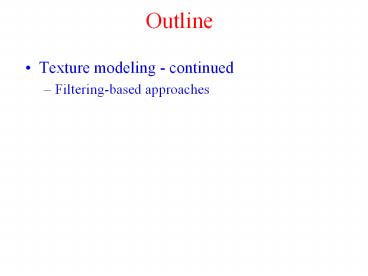Outline - PowerPoint PPT Presentation
Title:
Outline
Description:
Gabor filters have been widely in texture modeling ... This can be used for texture classification, texture boundary detection, and ... – PowerPoint PPT presentation
Number of Views:19
Avg rating:3.0/5.0
Title: Outline
1
Outline
- Texture modeling - continued
- Filtering-based approaches
2
Texture Modeling
- The structures of images
- The structures in images are due to the
inter-pixel relationships - The key issue is how to characterize the
relationships
3
Representing Textures through Filtering
- Filtering
- Convolving an image with a linear filter yields a
representation of the image on a different basis - The advantage of the transformation is that the
process makes the local structure of the image
clear - A filter can be viewed as a template
- There is a strong response when the local image
pattern looks similar to the filter kernel and a
weak response when it does not
4
Representing Textures through Filtering cont.
5
Representing Textures through Filtering cont.
6
Representing Textures through Filtering cont.
- Gabor filters
- Gabor filters have been widely in texture
modeling - Mathematically, Gabor filters are optimal in the
sense of local joint spatial/frequency
representation
7
Representing Textures through Filtering cont.
8
Representing Textures through Filtering cont.
- Problems with filtering-based approaches
- The filter response itself does not give rise to
a representation or a model for textures - Even for homogenous textures, the filter
responses are not homogenous
9
Representing Textures through Filtering cont.
10
Representing Textures through Filtering cont.
- Non-linear smoothing
- In order to derive a more homogenous and
meaningful feature for textures, the filter
responses are then passed through a non-linear
stage - The hope is that smoothed filter response will be
relative homogenous within a texture region - This can be used for texture classification,
texture boundary detection, and texture
discrimination
11
Texture Classification Based on Filtering
12
Texture Classification Based on Filtering cont.
13
Texture Classification Based on Filtering cont.
14
Texture Classification Based on Filtering cont.
15
Histograms of Filter Responses as Texture Models
- Histograms as texture features
- For homogenous textures, histograms should not
change very much - In other words, texture images with similar
histograms of filter responses should look
similar - Heeger and Bergen proposed a texture synthesis
algorithm based on this observation
16
Histograms of Filter Responses as Texture Models
cont.
17
Histograms of Filter Responses as Texture Models
cont.
18
Histograms of Filter Responses as Texture Models
cont.
19
Histograms of Filter Responses as Texture Models
cont.
20
Histograms of Filter Responses as Texture Models
cont.
21
Histograms of Filter Responses as Texture Models
cont.
22
Histograms of Filter Responses as Texture Models
cont.
23
Non-Parametric Sampling
- Non-parametric sampling
- When we need to decide a pixel value, we
calculate the conditional probability given the
pixel values in the surrounding neighborhood - This is done by finding the similar surrounding
neighborhood in the given texture
24
Non-Parametric Sampling cont.
25
Non-Parametric Sampling cont.
26
Non-Parametric Sampling cont.

